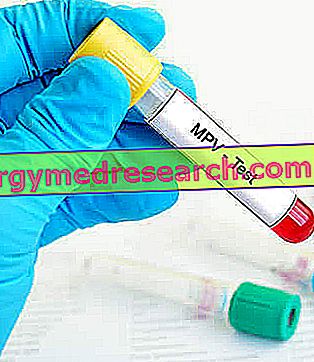Generality
Thyroxine (or T4 ) is the main iodinated hormone produced by the thyroid ; in particular, it is synthesized by the follicular cells of the gland, starting from thyroglobulin (Tg).

In the blood, the T4 hormone circulates linked to transport proteins; a smaller quota, instead, called FT4 is present in free form (not linked).
Determining the amount of thyroxine (total or free) is useful for assessing thyroid pathologies and explaining any abnormal TSH values.
What's this
Thyroxine or tetraiodothyronine - known more simply as T4 for the molecular structure characterized by 4 molecules of iodine - is the main thyroid hormone secreted by the follicular cells of the thyroid .
Once poured into the bloodstream, due to the lipophilicity that hinders its solubility in water-based liquids, such as blood, thyroxine is largely linked to the so-called TBG (acronym of Thyroid Binding Globulin, thyroxine-binding globulin), and to a lesser extent albumin and transthyretin.
Importance of Thyroglobulin and Free T4
Due to the low plasma concentration of thyroid hormones, TBG is rarely saturated over 25%; this means that, despite its low concentration in the circulation, TBG is usually present in excess of the proportion of thyroid hormones available for binding.
To acquire biological activity and regulate the metabolism in the target cells, thyroxine must necessarily be separated from this protein; this is why for some years it has been preferred to dose the plasma levels of the free fraction (free T4 ), rather than the absolute ones ( total T4 ).
The relationship between the two fractions - free and total - generally depends on the needs of the organism and on the activity of the thyroid; so in hypothyroidism, despite having a fairly low total amount of thyroxine we will (at least in theory) have a total T4 ratio / free T4 shifted in favor of the free altitude, while in the case of hyperthyroidism (excess thyroid hormones), the bound fraction TBG will be proportionally greater than the free one (in fact, by keeping the thyroxine bound to the plasma proteins the body tries to defend itself from the negative effects of its presence in excess).
Otherwise, there may be situations in which the patient appears to be hyperthyroid based on the absolute value of thyroxine, without however showing the typical signs and symptoms of this condition; this is the case, for example, of women on estrogen therapy, in which high levels of estrogen can increase the synthesis and binding of TBG against thyroid hormones; in the face of a reduced concentration of free T4, the body tries to compensate by increasing the synthesis of these hormones, stimulated by the pituitary hormone TSH; we will therefore have high values of total T4, high values of TBG, and normal values of free T4. The opposite situation occurs during therapies with corticosteroids or in the presence of liver diseases, factors that decrease the synthesis of TBG by the liver.
To summarize : while the total T4 values can be influenced by the amount of plasma proteins binding the thyroid hormones, the measurement of free T4, being independent of this factor, is more reliable for diagnostic purposes.
Importance of TSH values
Another important aspect is the comparison between the values of T4 with those of TSH . We have mentioned how this hormone, secreted by the pituitary gland in the center of the skull, stimulates the thyroid to produce more hormones. In the presence of hypothyroidism, and therefore of a low level of thyroid hormones in the blood, it is logical to expect high levels of TSH, in an attempt to stimulate the thyroid to produce more T4; vice versa in case of hyperthyroidism it is logical to expect low values of TSH.
However, there are exceptions that escape this rule; for example, pituitary adenomas that can increase or decrease the amount of secreted TSH regardless of T4 or T3 levels; TSH levels also appear low in Graves-Basedow disease, where abnormal antibodies bind to hormone receptors mimicking their biological stimulus action on T3 and T4 synthesis.
Beyond these and other rare conditions, measuring TSH plasma levels is also important for monitoring the efficacy of replacement therapy undertaken in hypothyroidism conditions. For example, high TSH values may signal an insufficient intake of thyroid hormone drugs (eg eutirox); and viceversa.
Why do you measure
Thyroxine examination is useful in assessing thyroid function .
In the blood, it is possible to determine both the free form of the hormone (the unbound one), and the total one (bound form + free form).
Thyroxine determination is normally used as an aid in the diagnosis and monitoring of thyroid pathologies.
When is the T4 hormone examination required?
The determination of the T4 hormone is indicated by the doctor in the following cases:
- To evaluate thyroid function;
- As a support to the diagnosis of thyroid diseases;
- For the screening of hypothyroidism in newborns;
- To monitor the course and effectiveness of therapy in the course of previously diagnosed thyroid diseases.
Normal values
Unique norm values are not available for the determination of T4. The reference intervals may differ in the various laboratories, as they depend on many factors, such as age and sex of the patient, analytical methods and instrumentation in use.
For this reason, it is preferable to consult the ranges reported directly on the analysis report. It should also be remembered that the results must be assessed as a whole by the medical doctor, who knows the patient's medical history.
T4 High - Causes
Increased values of thyroxine indicate the possibility of:
- Hyperthyroidism;
- Toxic goiter;
- Thyroid inflammation (thyroiditis);
- Early stage Hashimoto's thyroiditis.
T4 Low - Causes
Reduced thyroxine values are mainly due to:
- Hypothyroidism;
- Endemic goiter;
- Hashimoto thyroiditis in advanced stage.
How to measure it
Thyroxine examination is performed by simply drawing blood from a vein in the arm.
Preparation
The blood sampling for the determination of thyroxine is generally performed in the morning. Your doctor will suggest if you need to be fasting.
As a rule, plasma T4 levels are not influenced by the subject's lifestyle, so fasting or abstention from particular activities before sampling is not normally required.
It should be remembered that taking some medicines can interfere with the determination of T4. For this reason, it is advisable to communicate to the doctor all the medications that are taken.
If the patient takes thyroid hormones, it is recommended that he take the sample before the daily dose.
Interpretation of Results
| Normal thyroid values | |
| Thyroxine (T4) total (TT4) | 60 - 150 nmoles / L |
| Thyroxine (T4) free (fT4) | 10 - 25 pmoli / L |
| total triiodothyronine (T3) (TT3) | 1.1 - 2.6 nmol / L |
| triiodothyronine (T3) free (fT3) | 3.0 - 8.0 pmoli / L |
| Thyroid-stimulating hormone (or thyrotropin) (TSH) | 0.15 - 3.5 mU / L |
| NOTE: the normal ranges may vary from laboratory to laboratory; moreover, different units of measure are sometimes used (eg mcg / dl and ng / dl) and in this case the numerical values are completely different from those listed. Values may also vary based on age and pregnancy. For all these reasons, we advise you to refer to the normal ranges indicated in the analysis certificate . | |
In general, high levels of T4 are spies of an overactive thyroid, which produces an excessive amount of thyroid hormones, configuring the clinical picture of hyperthyroidism :
- Tachycardia;
- Anxiety;
- Weight loss;
- Sensation of warmth and impatience at high temperatures;
- Difficulty in falling asleep;
- Widespread tremors;
- Feeling of weakness;
- Hypersensitivity to light;
- Nervousness;
- Brittle nails and hair.
| TSH | T4 | T3 | Interpretation |
| High | Normal | Normal | Moderate hypothyroidism (subclinical) |
| High | Bass | Low or normal | Obvious hypothyroidism |
| Norma. | Normal | Normal | Euthyroidism (healthy patient) |
| Bass | Normal | Normal | Moderate hyperthyroidism (subclinical) |
| Bass | High or normal | High or normal | Manifested hyperirodism |
| Bass | Low or normal | Low or normal | Rare hypothyroidism pituitary (secondary) |
Conversely, low levels of T4 in the blood suggest thyroid insufficiency ; in similar circumstances, the gland does not produce sufficient amounts of hormones and the classic symptoms of hypothyroidism appear, in many ways opposed to the previous ones:
- Weight gain;
- Dry skin;
- Constipation;
- Intolerance at low temperatures;
- Fatigue;
- Menstrual irregularity;
- Hair loss;
- Edema.
Influence of drugs on T4 values
Numerous drugs can decrease or increase total T4 levels; among the first we mention anabolic steroids, androgens, anti-thyroid drugs (propylthiouracil and methimazole), interferon alpha, interleukin 2, lithium, propanolol and phenytoin; instead, they are able to increase total T4 levels: birth control pills, chlorofibrate, estrogens and methadone. For this reason, before performing the analysis of blood T4 it is important to inform your doctor about any ongoing drug therapies. Generally, free T4 values are not affected by these drugs.
Pregnancy and Stress
Pregnancy may be accompanied by mild increases in total T4, as it tends to increase TBG synthesis.
When the organism is sick, or subject to strong stress, the peripheral synthesis of T3 decreases; so most hospitalized and cachectic patients show low plasma T3 and T4 levels.



